 Facebook
Facebook
 X
X
 Instagram
Instagram
 TikTok
TikTok
 Youtube
Youtube
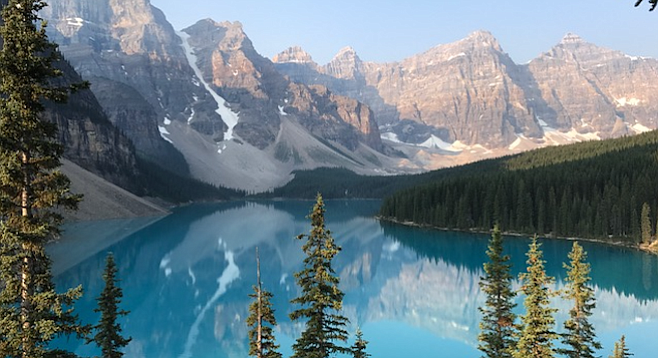
“Keep close to nature’s heart….and break clear away, once in awhile, and climb a mountain or spend a week in the woods. Wash your spirit clean.” ~ John Muir
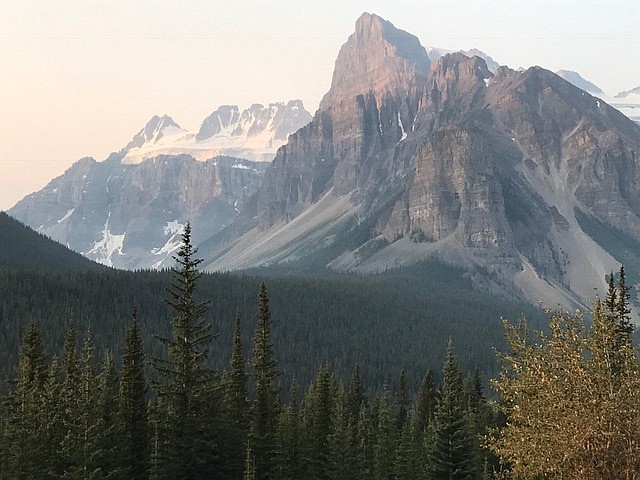
The stretch of Canadian Rockies encompassing Banff, Jasper, and Yoho National Parks must be among the most stunning slices of natural wonder in the world. Glaciers, mountains, gorges, lakes, waterfalls, rivers, and forests all create a scenic mélange that mesmerizes the senses. Some of the views make you want to just stop and stare in awe and wonder. The magnificence of what nature has to offer in and around the parks rivals the scenic beauty of anything in America and probably the world.
If you want to visit both parks (and you certainly should if you have anything close to a week in this part of the world), take Highway 93A, otherwise known as the Icefields Parkway, after flying into either Edmonton, closest city to Jasper, or Calgary, closest city to Banff. The Icefields Parkway connects Banff and Jasper National Parks. After traversing it twice, I’ve determined it has to be in the conversation of the most spectacular drives in the world. Certainly in Canada.
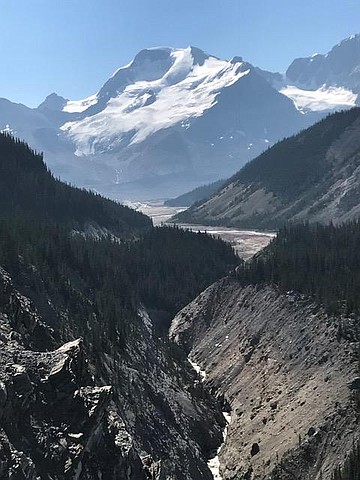
The main problem with this drive is the difficulty of keeping your eyes on the road with so much jaw- dropping scenery behind and around every crook and bend. It’s best to start early, as the easiest access and best views for some of the most popular sites are in the early morning. Stop at one of the visitor centers in Jasper, Banff or Lake Louise to pick up a free map, the Parks Pass, self-guided tour brochures, and any other information you need to plan your journey.
The Parks Canada Discovery Pass, which allows entry to all Canadian national parks, is free this year to commemorate Canada’s 150th birthday. Parks Canada has a worthwhile website where you can order the pass online and find additional helpful information in planning your trip.
One of the most popular stops along the parkway is the Columbia Icefield Center, where you can book a tour to the Athabasca Glacier, the most impressive of the 100 glaciers along the parkway, and walk on the ice, something you are prohibited from doing on your own. A bit further west, The Glacier Skywalk is a glass-bottomed overhang with a nearly 1,000-foot drop offering breathtaking views over the surrounding landscape. Some other highlights of the drive for me included Bow Lake, Peyto Lake, Athabasca Falls, and Sunwapta Falls. Even though the drive itself only takes about three hours, it took me a full day — and even then I didn’t see everything of interest. There are so many enticing viewpoint stops along the way, it’s difficult to take in all of them in one day.
Inevitably at some point along the parkway or within the parks during your journey, you'll hit a backlog of halted traffic. This probably indicates a bear or elk sighting along the road. This happened several times during my travels here. Leave plenty of flexibility in your schedule for these unexpected encounters and time to simply linger free of anxiety over the schedule.
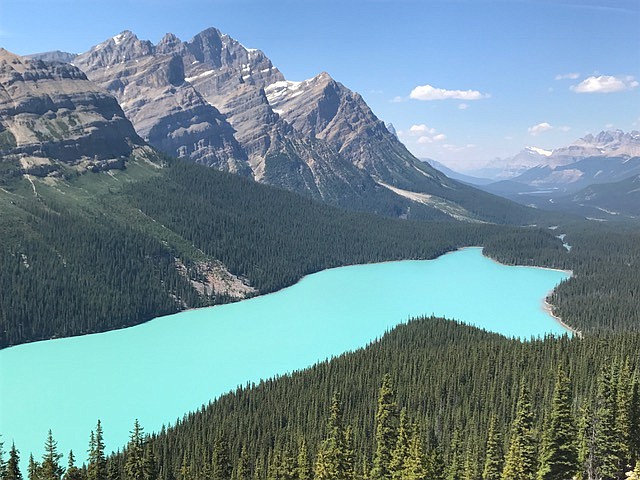
The parks are home to some of the most exquisite (and deep blue) lakes you will ever see. Among the most popular are Moraine Lake, Lake Louise, and Peyto Lake, all located in Banff, and Lake Maligne in Jasper where you can take a cruise to the lovely and secluded Spirit Island. Lake Maligne is the second largest glacier-fed lake in the world.
I flew into Calgary in August, and the parks were packed at the most popular sites such as the aforementioned lakes. When visiting any of these during the summer, it’s wise to go early; the parking lots start to fill up by 9 or 10. Shuttles are available to Moraine Lake, Lake Minnewanka and Lake Louise so you don’t need to gamble with finding a parking spot.
To escape the hordes of visitors at the most popular sites, I particularly enjoyed taking hikes at some of the less populated trails, such as the loops around Lake Johnson and the lovely Emerald Lake in Yoho National Park. No matter how crowded the parks are, you can find a trail that will bring you to a place of solitude where you can catch a breath and appreciate the wonders of nature.
“Your deepest roots are in nature. No matter who you are, where you live, or what kind of life you lead, you remain irrevocably linked with the rest of creation.” ~ Charles Cook
Banff and Jasper National Parks both have small towns with the same names. Banff and Jasper are essentially tourist towns with souvenir shops, not particularly noteworthy except as home bases for the surrounding wilderness. The information centers in each town, however, deserve a stop. You might consider selecting one of the gondolas in Banff, Jasper and Lake Louise for a panoramic view of the Canadian Rockies. You can view images of each gondola online before deciding on a choice.
Close to the town of Jasper are Patricia and Pyramid Lakes, where you may be tempted to laze away the better part of a day. These are popular swimming lakes, and you have a decent chance to spot moose, elk and other wildlife in the area. The hour drive from Jasper to Maligne Lake is quite scenic and worth a few stops for photos, particularly at Medicine Lake and Maligne Canyon. Another popular activity in Jasper NP is rafting down the Athabasca River. Mt. Edith Cavell, Jasper’s tallest mountain, is a favorite spot among more ambitious hikers. The mountain features Angel Glacier, which flows down the north face. The glacier got its name from its resemblance to an angel with outstretched wings.
“I believe the world is incomprehensibly beautiful, an endless prospect of magic and wonder.” ~ Ansel Adams
In Banff NP, there are endless opportunities for transcendent moments in nature. Try to experience sunset at Mt. Rundle and dawn at Lake Minnewanka. Visitors and locals enjoy visiting Johnston Canyon, which features a pair of photogenic waterfalls. A relatively easy 1.1-km hike will take you to the Lower Falls; a slightly more difficult climb of 2.6 km will get you to the Upper Falls. Sunshine Meadows offers a spectacular hike that was unfortunately closed during my visit due to nearby fires. Moraine Lake Valley of the Ten Peaks provides a spectacular backdrop for — in my opinion (sorry Lake Louise) — the most photogenic and mesmerizing lake of them all, Moraine Lake (top).
Many locals claim that winter is just as worthwhile a time to visit Banff as summer. Skiing here is a favorite winter activity. Keep in mind, however, that many of the favorite spots such as Moraine Lake are closed. Others say that shoulder season in autumn just before the weather turns wintry is the best time to visit. Regardless of what season you arrive, you can save money by staying in Canmore, a small town just outside the park. Prices for accommodation are much less expensive there than in Banff.
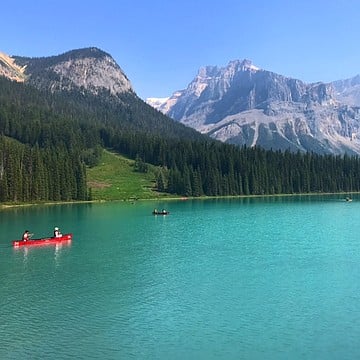
If you have time, it’s worthwhile to visit Yoho National Park in British Columbia, about a 20-minute drive from Lake Louise. Explore beautiful Emerald Lake by renting a canoe or taking the loop trail around the lake, which will reveal mountain vistas and lead you through a thick forest. You will also have the option to branch off into longer, more ambitious hikes.
Lake O Hara, also in Yoho NP at an elevation of 2,020 meters, is a favorite for many locals. Visitors, however, should make reservations several months in advance to visit here, especially in the summer as there is limited access. The Lake O Hara Alpine Circuit, considered one of the best hikes in the world, connects several scenic shorter trails into a challenging but rewarding day hike. I didn’t make it here on my trip, but it’s on my list of must-see spots when I return. Another highlight of a visit to Yoho NP is Takakkaw Falls, one of the highest waterfalls in Canada.
Yet another nearby national park is Kootenay National Park. I hear that the scenery here rivals that of the other parks, but there were some fires raging in the area during my visit, so I did not make it there during this trip.
“Those who contemplate the beauties of the earth find reserves of strength that will endure as long as life lasts.” ~ Rachel Carson
Leave as much time as you can for such moments of quiet reflection in the national parks of the Canadian Rockies, one of the most gorgeous locations on earth.


“Keep close to nature’s heart….and break clear away, once in awhile, and climb a mountain or spend a week in the woods. Wash your spirit clean.” ~ John Muir

The stretch of Canadian Rockies encompassing Banff, Jasper, and Yoho National Parks must be among the most stunning slices of natural wonder in the world. Glaciers, mountains, gorges, lakes, waterfalls, rivers, and forests all create a scenic mélange that mesmerizes the senses. Some of the views make you want to just stop and stare in awe and wonder. The magnificence of what nature has to offer in and around the parks rivals the scenic beauty of anything in America and probably the world.
If you want to visit both parks (and you certainly should if you have anything close to a week in this part of the world), take Highway 93A, otherwise known as the Icefields Parkway, after flying into either Edmonton, closest city to Jasper, or Calgary, closest city to Banff. The Icefields Parkway connects Banff and Jasper National Parks. After traversing it twice, I’ve determined it has to be in the conversation of the most spectacular drives in the world. Certainly in Canada.

The main problem with this drive is the difficulty of keeping your eyes on the road with so much jaw- dropping scenery behind and around every crook and bend. It’s best to start early, as the easiest access and best views for some of the most popular sites are in the early morning. Stop at one of the visitor centers in Jasper, Banff or Lake Louise to pick up a free map, the Parks Pass, self-guided tour brochures, and any other information you need to plan your journey.
The Parks Canada Discovery Pass, which allows entry to all Canadian national parks, is free this year to commemorate Canada’s 150th birthday. Parks Canada has a worthwhile website where you can order the pass online and find additional helpful information in planning your trip.
One of the most popular stops along the parkway is the Columbia Icefield Center, where you can book a tour to the Athabasca Glacier, the most impressive of the 100 glaciers along the parkway, and walk on the ice, something you are prohibited from doing on your own. A bit further west, The Glacier Skywalk is a glass-bottomed overhang with a nearly 1,000-foot drop offering breathtaking views over the surrounding landscape. Some other highlights of the drive for me included Bow Lake, Peyto Lake, Athabasca Falls, and Sunwapta Falls. Even though the drive itself only takes about three hours, it took me a full day — and even then I didn’t see everything of interest. There are so many enticing viewpoint stops along the way, it’s difficult to take in all of them in one day.
Inevitably at some point along the parkway or within the parks during your journey, you'll hit a backlog of halted traffic. This probably indicates a bear or elk sighting along the road. This happened several times during my travels here. Leave plenty of flexibility in your schedule for these unexpected encounters and time to simply linger free of anxiety over the schedule.

The parks are home to some of the most exquisite (and deep blue) lakes you will ever see. Among the most popular are Moraine Lake, Lake Louise, and Peyto Lake, all located in Banff, and Lake Maligne in Jasper where you can take a cruise to the lovely and secluded Spirit Island. Lake Maligne is the second largest glacier-fed lake in the world.
I flew into Calgary in August, and the parks were packed at the most popular sites such as the aforementioned lakes. When visiting any of these during the summer, it’s wise to go early; the parking lots start to fill up by 9 or 10. Shuttles are available to Moraine Lake, Lake Minnewanka and Lake Louise so you don’t need to gamble with finding a parking spot.
To escape the hordes of visitors at the most popular sites, I particularly enjoyed taking hikes at some of the less populated trails, such as the loops around Lake Johnson and the lovely Emerald Lake in Yoho National Park. No matter how crowded the parks are, you can find a trail that will bring you to a place of solitude where you can catch a breath and appreciate the wonders of nature.
“Your deepest roots are in nature. No matter who you are, where you live, or what kind of life you lead, you remain irrevocably linked with the rest of creation.” ~ Charles Cook
Banff and Jasper National Parks both have small towns with the same names. Banff and Jasper are essentially tourist towns with souvenir shops, not particularly noteworthy except as home bases for the surrounding wilderness. The information centers in each town, however, deserve a stop. You might consider selecting one of the gondolas in Banff, Jasper and Lake Louise for a panoramic view of the Canadian Rockies. You can view images of each gondola online before deciding on a choice.
Close to the town of Jasper are Patricia and Pyramid Lakes, where you may be tempted to laze away the better part of a day. These are popular swimming lakes, and you have a decent chance to spot moose, elk and other wildlife in the area. The hour drive from Jasper to Maligne Lake is quite scenic and worth a few stops for photos, particularly at Medicine Lake and Maligne Canyon. Another popular activity in Jasper NP is rafting down the Athabasca River. Mt. Edith Cavell, Jasper’s tallest mountain, is a favorite spot among more ambitious hikers. The mountain features Angel Glacier, which flows down the north face. The glacier got its name from its resemblance to an angel with outstretched wings.
“I believe the world is incomprehensibly beautiful, an endless prospect of magic and wonder.” ~ Ansel Adams
In Banff NP, there are endless opportunities for transcendent moments in nature. Try to experience sunset at Mt. Rundle and dawn at Lake Minnewanka. Visitors and locals enjoy visiting Johnston Canyon, which features a pair of photogenic waterfalls. A relatively easy 1.1-km hike will take you to the Lower Falls; a slightly more difficult climb of 2.6 km will get you to the Upper Falls. Sunshine Meadows offers a spectacular hike that was unfortunately closed during my visit due to nearby fires. Moraine Lake Valley of the Ten Peaks provides a spectacular backdrop for — in my opinion (sorry Lake Louise) — the most photogenic and mesmerizing lake of them all, Moraine Lake (top).
Many locals claim that winter is just as worthwhile a time to visit Banff as summer. Skiing here is a favorite winter activity. Keep in mind, however, that many of the favorite spots such as Moraine Lake are closed. Others say that shoulder season in autumn just before the weather turns wintry is the best time to visit. Regardless of what season you arrive, you can save money by staying in Canmore, a small town just outside the park. Prices for accommodation are much less expensive there than in Banff.

If you have time, it’s worthwhile to visit Yoho National Park in British Columbia, about a 20-minute drive from Lake Louise. Explore beautiful Emerald Lake by renting a canoe or taking the loop trail around the lake, which will reveal mountain vistas and lead you through a thick forest. You will also have the option to branch off into longer, more ambitious hikes.
Lake O Hara, also in Yoho NP at an elevation of 2,020 meters, is a favorite for many locals. Visitors, however, should make reservations several months in advance to visit here, especially in the summer as there is limited access. The Lake O Hara Alpine Circuit, considered one of the best hikes in the world, connects several scenic shorter trails into a challenging but rewarding day hike. I didn’t make it here on my trip, but it’s on my list of must-see spots when I return. Another highlight of a visit to Yoho NP is Takakkaw Falls, one of the highest waterfalls in Canada.
Yet another nearby national park is Kootenay National Park. I hear that the scenery here rivals that of the other parks, but there were some fires raging in the area during my visit, so I did not make it there during this trip.
“Those who contemplate the beauties of the earth find reserves of strength that will endure as long as life lasts.” ~ Rachel Carson
Leave as much time as you can for such moments of quiet reflection in the national parks of the Canadian Rockies, one of the most gorgeous locations on earth.
Comments